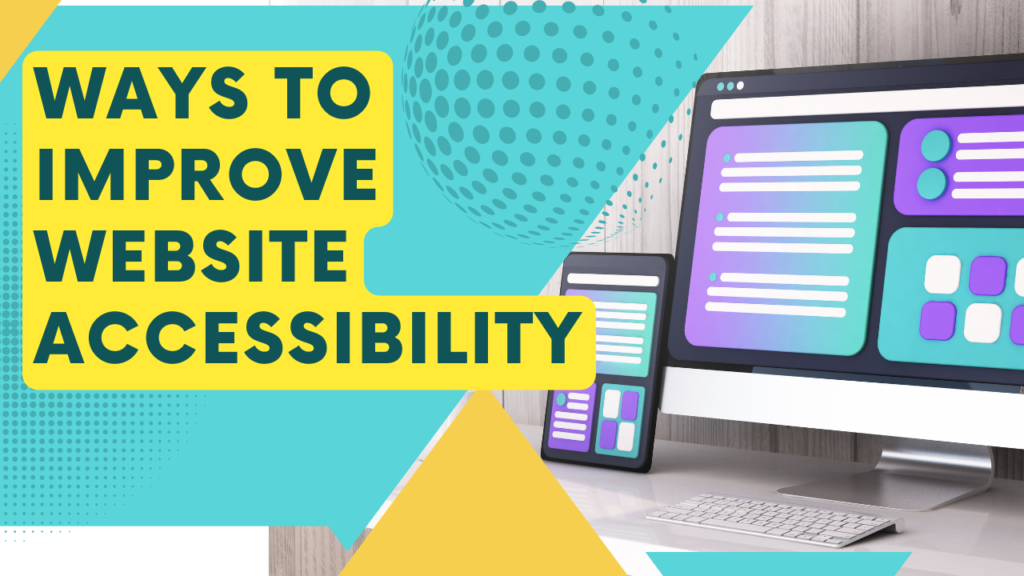Website accessibility has become a critical aspect for businesses and organizations to consider in today’s digital era. Website accessibility refers to the ability of people with disabilities, such as visual, auditory, or physical impairments, to use a website effectively. The importance of website accessibility cannot be exaggerated, as it enables businesses to reach a broader audience, improve user experience, and comply with legal requirements.
Ways to Improve your Website’s Accessibility
Below are 8 simple actions you can take right now to improve your website accessibility.
1. Clear and Concise Writing
Clear and concise writing is a crucial aspect of quality content that can improve website accessibility. People with visual or cognitive disabilities often struggle with long paragraphs and complex sentences. Therefore, using simple language and breaking up content into smaller chunks can make it more accessible.
Moreover, using headings, subheadings, and bullet points can help users with screen readers navigate the content easily. Screen readers are assistive technology devices that read the content aloud for people with visual impairments. Applying these formatting options can make it easier for screen readers to interpret the content, thus improving website accessibility.
2. Alternative Text for Images
Alternative text, also known as alt text, is a description of an image that is read aloud by screen readers. It helps people with visual impairments understand the content of the picture. Therefore, using alternative text for images is a dominant aspect of website accessibility.
Creating alt text is relatively easy. You can directly describe the content of the picture in a sentence or two, using relevant keywords. That not only makes the website more accessible but also improves search engine optimization (SEO) as search engines can read alt text and use it to rank the website in search results.
3. Video and Audio Transcriptions
Videos and audio content are becoming increasingly popular on websites. However, people with hearing impairments may find it difficult to understand the content. Therefore, providing transcriptions of videos and audio content can improve website accessibility.
Transcriptions are text versions of the audio or video content, which can be read by screen readers or displayed on the website. That enables people with hearing impairments to understand the content and engage with the website. Additionally, transcriptions can improve SEO as search engines can read and use the text to rank the website.
4. Descriptive Links
Links are an essential part of website content. They provide additional information and enable users to navigate to different pages. However, people with visual impairments may find it difficult to understand the context of the link without additional information. Therefore, using descriptive links can improve website accessibility.
Descriptive links provide additional information about the content of the link. For example, instead of applying “click here,” you can use “download the brochure here.” That provides context and makes it easier for screen readers to interpret the content of the link.
5. Readability and Language
Readability and language are critical aspects of website accessibility. Using complex language and jargon can make it difficult for people with cognitive impairments to understand the content. Therefore, using simple language and avoiding jargon can improve website accessibility.
Moreover, using appropriate language and avoiding discriminatory or offensive language can make the website more inclusive. That is important as it shows that the website is accessible to all users, regardless of their background or identity.

6. Consistent Navigation
Consistent navigation is a dominant aspect of website accessibility. People with cognitive impairments often find it difficult to navigate websites that have inconsistent navigation. Therefore, using consistent navigation can improve website accessibility.
Consistent navigation refers to using the same navigation structure on all website pages. That enables users to navigate the website easily and, predictable navigation helps users with disabilities to understand the website’s composition and locate the information they need.
7. Responsive Design
Responsive design is an essential aspect of website accessibility. Responsive design ensures that the website adapts to different screen sizes and devices, making it accessible to all users. People with disabilities may access the website using disparate devices and screen sizes. Therefore, ensuring that the website is responsive can improve website accessibility.
Responsive design ensures that the website’s content is better for different screen sizes and devices. That means the website’s layout and design adapt to the device, making it easier to use for people with disabilities.
8. Testing and Feedback
Testing and feedback are essential for improving website accessibility. Conducting accessibility testing ensures that the website meets the needs of people with disabilities. Moreover, gathering comments from users with disabilities can help identify areas for improvement and make the website more accessible.
Accessibility testing involves using tools and techniques to evaluate the website’s accessibility. That can include utilizing screen readers, keyboard navigation, and other assistive technology devices. Moreover, user testing can involve gathering feedback from people with disabilities to identify areas for improvement and ensure that the website is accessible.
Final Words
By implementing these strategies, businesses and organizations can ensure that their websites are inclusive, providing equal opportunities for all users to access information and engage with their products or services. Improving website accessibility is a legal requirement and a moral and social responsibility to create a more inclusive and equitable society.

